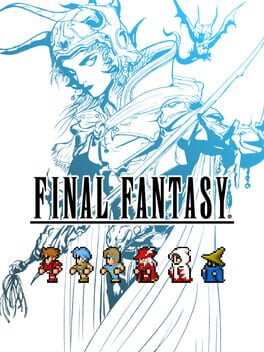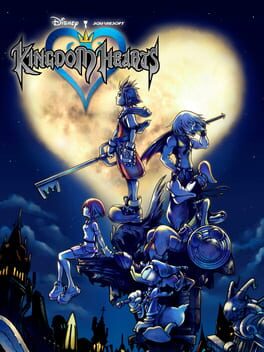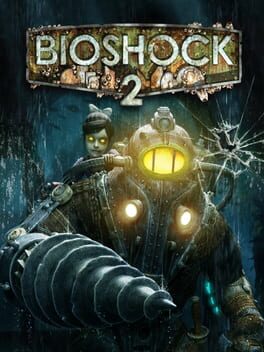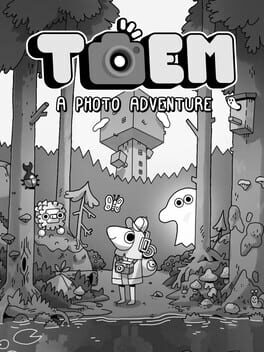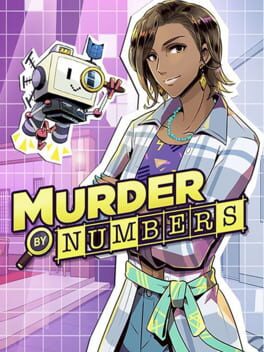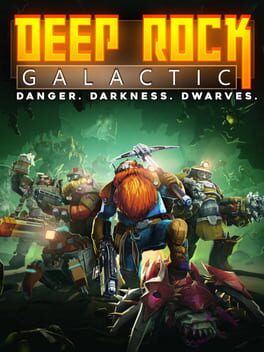WubGaming
624 Reviews liked by WubGaming
Final Fantasy
2021
Kingdom Hearts
2002
BioShock 2
2010
Fire Emblem Engage
2023
This game is actually amazing. Story wasn't anything special, but it I like some of the story beats and how it incorporated its story into gameplay quite a few times. Definitely a lot of great moments present, and it is unfortunate that people will write it off.
There were plenty of times where you are powerless in the story, and then on the same map the game exactly makes you feel the same way. Something we have been missing in Fire Emblem since arguably Thracia?
The game goes back to the GBA days and make supports very quick and simple, meaning after a map you don't have to spend a long time reading all of the supports. Not to say the characters are hot garbage, there are definitely good ones even with the change of length in them.
I played the game on Maddening and the gameplay itself is REALLY player phase heavy, which is awesome because that means you spend time more strategizing which is very welcomed for a strategy game. Generally the maps have a very consistently alright to good quality (with some really cool ones). Paralogues are definitely the maps with the lowest quality, but I'd argue you could blame the respective games for its quality. (on Maddening they are NEAR identical to the source material)
I had fun, only issue are the hit rate getting pretty shake late game and it gets kinda annoying when using the turnwheel doesn't even reset RN. It takes the FE12 H3 endgame approach where you want to fucking finish every late game map as fast as possible and the Thracia approach of using your entire arsenal to deal with every problem. Which I think is a fine thing at least, but a kinda annoying while dealing with hit rates.
My other complaint is that the UI has been a downgrade compared to its predecessors, a lot of design choices baffles me and it shouldn't be this hard just to look at a might of a weapon.
An insane amount of tools that the game gives you, story that works with the game, pretty good fanservice for older fans, amazing animations, beautiful looking world. A lot of steps forward, I am very content with this game. Definitely a favorite in the series for me.
There were plenty of times where you are powerless in the story, and then on the same map the game exactly makes you feel the same way. Something we have been missing in Fire Emblem since arguably Thracia?
The game goes back to the GBA days and make supports very quick and simple, meaning after a map you don't have to spend a long time reading all of the supports. Not to say the characters are hot garbage, there are definitely good ones even with the change of length in them.
I played the game on Maddening and the gameplay itself is REALLY player phase heavy, which is awesome because that means you spend time more strategizing which is very welcomed for a strategy game. Generally the maps have a very consistently alright to good quality (with some really cool ones). Paralogues are definitely the maps with the lowest quality, but I'd argue you could blame the respective games for its quality. (on Maddening they are NEAR identical to the source material)
I had fun, only issue are the hit rate getting pretty shake late game and it gets kinda annoying when using the turnwheel doesn't even reset RN. It takes the FE12 H3 endgame approach where you want to fucking finish every late game map as fast as possible and the Thracia approach of using your entire arsenal to deal with every problem. Which I think is a fine thing at least, but a kinda annoying while dealing with hit rates.
My other complaint is that the UI has been a downgrade compared to its predecessors, a lot of design choices baffles me and it shouldn't be this hard just to look at a might of a weapon.
An insane amount of tools that the game gives you, story that works with the game, pretty good fanservice for older fans, amazing animations, beautiful looking world. A lot of steps forward, I am very content with this game. Definitely a favorite in the series for me.
Tunic
2022
I think its OK to cheat at video games. Probably not chess (#magnusisinnocent) or other competitive ones, but like, I think if you're stuck on a puzzle, and you've given it the old college try, I think there's nothing wrong with googling "spoderman how do i shot web" every once in a while. If you're legitimately stuck, what else are you going to do otherwise? Just drop the game? That's dumb.
I tried really hard not to cheat at Tunic. Really hard. I did succumb, a few times, and a few more times than that, I tried to succumb and just look up the answer but I failed to phrase it right and didn't find anything out. What's cool about Tunic is that it plays into the impulse of looking stuff up by giving you that nice old Manual. Making you find that manual, piece by piece--you have to literally build your understanding of the game page by page. Once you've got it all together, you can figure out what questions you're really asking.
Tunic sells itself as a Zelda or Soulslike; moreso than those it is a Fezlike, but even more than that this game is a Flower, Sun, and Rain-like. The game doesn't really begin until you are reading through the manual, back and forth, digging for secrets. I don't really have any idea what any of the lore in this game meant, or what any of the weird runic language is saying; what I do know is that I beat this game, and what it means to do that. And figuring that out ruled. The puzzles in this game are labyrinths, and what a joy it is to walk them.
I tried really hard not to cheat at Tunic. Really hard. I did succumb, a few times, and a few more times than that, I tried to succumb and just look up the answer but I failed to phrase it right and didn't find anything out. What's cool about Tunic is that it plays into the impulse of looking stuff up by giving you that nice old Manual. Making you find that manual, piece by piece--you have to literally build your understanding of the game page by page. Once you've got it all together, you can figure out what questions you're really asking.
Tunic sells itself as a Zelda or Soulslike; moreso than those it is a Fezlike, but even more than that this game is a Flower, Sun, and Rain-like. The game doesn't really begin until you are reading through the manual, back and forth, digging for secrets. I don't really have any idea what any of the lore in this game meant, or what any of the weird runic language is saying; what I do know is that I beat this game, and what it means to do that. And figuring that out ruled. The puzzles in this game are labyrinths, and what a joy it is to walk them.
Toem
2021
For some reason I often confuse this game with "Neom," the Saudi-Arabian concept city that has yet to be constructed along a 110-mile long by 200 yard wide strip of desert for seemingly no reason other than to flaunt wealth, spark innovation, and tempt fate. Toem doesn't really do any of those things, it's just a short and sweet indie photo game.
Journey
2012
Philip Guedalla informs us that the novel The Approach to al-Mu'tasim by the Bombay barrister Mir Bahadur Ali ’is a rather uneasy combination of those Islamic allegories which never fail to impress their own translators, and of that brand of detective story which inevitably outdoes even Dr Watson and heightens the horror of human life as it is found in the most respectable boarding-houses of Brighton.' Before him, Mr Cecil Roberts had blasted Bahadur's book for ’its unaccountable double influence of Wilkie Collins and of the famed twelfth-century Persian, Ferid Eddin Attar' - a simple enough observation which Guedalla merely parrots, though in an angrier jargon. Essentially, both reviewers are in agreement, pointing out the book's detective-story mechanism and its undercurrent of mysticism. This hybridization may lead us to suspect a certain kinship with Chesterton; we shall presently find out, however, that no such affinity exists.
The first edition of The Approach to al-Mu'tasim appeared in Bombay towards the end of 1932. The paper on which the volume was issued, I am told, was almost newsprint; the jacket announced to the purchaser that the book was the first detective novel to be written by a native of Bombay City. Within a few months, four printings of a thousand copies each were sold out. The Bombay Quarterly Review, the Bombay Gazette, the Calcutta Review, the Hindustani Review (of Allahabad), and the Calcutta Englishman all sang its praises. Bahadur then brought out an illustrated edition, which he retitled The Conversation with the Man Called al-Mu'tasim and rather beautifully subtitled A Game with Shifting Mirrors. This is the edition which Victor Gollancz has just reissued in London, with a foreword by Dorothy L. Sayers and the omission - perhaps merciful - of the illustrations. It is this edition that I have at hand; I have not been able to obtain a copy of the earlier one, which I surmise may be a better book. I am drawn to this suspicion by an appendix summarizing the differences between the 1932 and the 1934 editions. Before attempting a discussion of the novel, it might be well to give some idea of the general plot.
Its central figure - whose name we are never told - is a law student in Bombay. Blasphemously, he disbelieves in the Islamic faith of his fathers, but, on the tenth night of the moon of Muharram, he finds himself in the midst of a civil disorder between Muslims and Hindus. It is a night of drums and prayers. The great paper canopies of the Muslim procession force their way through the heathen mob. A hail of Hindu bricks hurtles down from a roof terrace. A knife sinks into a belly. Someone - Muslim? Hindu? - dies and is trampled on. Three thousand men are fighting - stick against revolver, obscenity against curse, God the Indivisible against the many gods. Instinctively, the student freethinker joins in the battle. With his bare hands, he kills (or thinks he has killed) a Hindu. The Government police - mounted, thunderous, and barely awake - intervene, dealing out impartial lashes. The student flees, almost under the legs of the horses, heading for the farthest ends of town. He crosses two sets of railway lines, or the same lines twice. He scales the wall of an unkempt garden at one corner of which rises a circular tower. 'A lean and evil mob of mooncoloured hounds' lunges at him from the black rose-bushes. Pursued, he seeks refuge in the tower. He climbs an iron ladder - two or three rungs are missing - and on the flat roof, which has a dark pit in the middle, comes upon a squalid man in a squatting position, urinating vigorously by the light of the moon. The man confides to him that his profession is stealing gold teeth from the white-shrouded corpses that the Parsees leave on the roof of the tower. He says a number of other vile things and mentions, in passing, that fourteen nights have lapsed since he last cleansed himself with buffalo dung. He speaks with obvious anger of a band of horse thieves from Gujarat, 'eaters of dogs and lizards - men, in short, as abominable as the two of us’. Day is dawning. In the sky is a low flight of well-fed vultures. The student, in utter exhaustion, lies down to sleep. When he wakes up, the sun is high overhead and the thief is gone. Gone also are a couple of Trichinopoly cigars and a few silver rupees. Shaken by the events of the night before, the student decides to lose himself somewhere within the bounds of India. He knows he has shown himself capable of killing an infidel, but not of knowing with certainty whether the Muslim is more justified in his beliefs than the infidel. The mention of Gujarat haunts him, as does the name of a malka-sansi (a woman belonging to a caste of thieves) from Palanpur, many times favoured by the curses and hatred of the despoiler of corpses. He reasons that the anger of a man so thoroughly vile is in itself a kind of praise. He resolves - though rather hopelessly - to find her. He prays and sets out slowly and deliberately on his long journey. So ends the novel’s second chapter.
It is hardly possible to outline here the involved adventures that befall him in the remaining nineteen. There is a baffling pullulation of dramatis personae, to say nothing of a biography that seems to exhaust the range of the human spirit (running from infamy to mathematical speculation) or of a pilgrimage that covers the vast geography of India. The story begun in Bombay moves on into the lowlands of Palanpur, lingers for an evening and a night before the stone gates of Bikaner, tells of the death of a blind astrologer in a Benares sewer; the hero becomes involved in a conspiracy in a mazelike palace in Katmandu, prays and fornicates in the pestilential stench of the Machua Bazaar in Calcutta, sees the day born out of the sea from a law office in Madras, sees evenings die in the sea from a balcony in the state of Travancore, falters and kills in Indapur. The adventure closes its orbit of miles and years back in Bombay itself just a few yards away from the garden of the 'mooncoloured hounds’. The underlying plot is this: a man, the fugitive student freethinker we already know, falls among the lowest class of people and, in a kind of contest of evil-doing, takes up their ways. All at once, with the wonder and terror of Robinson Crusoe upon discovering the footprint of a man in the sand, he becomes aware of a sudden brief change in that world of ruthlessness - a certain tenderness, a moment of happiness, a forgiving silence in one of his loathsome companions. 'It was as though a stranger, a third and more subtle person, had entered into the conversation.' The hero knows that the scoundrel he is talking to is quite incapable of this unexpected turn; he therefore deduces that the man is echoing someone else, a friend, or the friend of a friend. Rethinking the problem, he arrives at the mysterious conclusion that 'somewhere on earth is a man from whom this light emanates; somewhere on earth a man exists who is equal to this light.’ The student decides to spend his life in search of him.
The story's outline is now plain: the tireless search for a human soul through the barely perceptible reflections cast by this soul in others - at first, the faint trace of a smile or of a word; in the end, the multiple branching splendours of reason, imagination, and righteousness. The nearer to al-Mu'tasim the men he examines are, the greater is their share of the divine, though it is understood that they are but mirrors. A mathematical analogy may be helpful here. Bahadur's teeming novel is an ascendant progression whose last term is the foreshadowed 'man called al-Mu'tasim'. Al-Mu'tasim's immediate predecessor is a Persian bookseller, an exceptionally happy, courteous man; the one before him, a saint. Finally, after many years, the student comes to a corridor 'at whose end is a door and a cheap beaded curtain, and behind the curtain a shining light'. The student claps his hands once or twice and asks for al-Mu'tasim. A man's voice - the unimaginable voice of al-Mu'tasim - invites him in. The student parts the curtain and steps forward. At this point, the novel ends.
If I am not mistaken, the proper handling of such a plot places the writer under two obligations. One, to abound richly in prophetic touches; the other, to make us feel that the person foreshadowed by these touches is more than a mere convention or phantom. Bahadur fulfils the first; how far he achieves the second, I wonder. In other words, the unheard and unseen al-Mu'tasim should leave us with the impression of a real character, not of a clutter of insipid superlatives. In the 1932 version, there are few supernatural touches; 'the man called al-Mu'tasim' is obviously a symbol, though he is not devoid of personal traits. Unfortunately, this literary good conduct did not last. In the 1934 version - the one I have read - the novel descends into allegory. Al-Mu'tasim is God, and the hero's various wanderings are in some way the journey of a soul on its ascending steps towards the divine union. There are a few regrettable details: a black Jew from Cochin speaks of al-Mu'tasim as having dark skin; a Christian describes him standing on a height with his arms spread open; a Red lama recalls him seated 'like that figure I modelled in yak butter and worshipped in the monastery of Tachilhunpo'. These statements seem to suggest a single God who reconciles himself to the many varieties of mankind. In my opinion, the idea is not greatly exciting. I will not say the same of another idea - the hint that the Almighty is also in search of Someone, and that Someone of Someone above him (or Someone simply indispensable and equal), and so on to the End (or, rather, Endlessness) of Time, or perhaps cyclically. Al-Mu'tasim (the name of that eighth Abbasid caliph who was victorious in eight battles, fathered eight sons and eight daughters, left eight thousand slaves, and ruled for a period of eight years, eight moons, and eight days) means etymologically 'The Seeker after Help'. In the 1932 version, the fact that the object of the pilgrimage was himself a pilgrim justified well enough the difficulty of finding him. The later version gives way to the quaint theology I have just mentioned. In the twentieth chapter, words attributed by the Persian bookseller to al-Mu'tasim are, perhaps, the mere heightening of others spoken by the hero; this and other hidden analogies may stand for the identity of the Seeker with the Sought. They may also stand for an influence of Man on the Divinity. Another chapter hints that al-Mu'tasim is the Hindu the student believes he has killed. Mir Bahadur Ali, as we have seen, cannot refrain from the grossest temptation of art - that of being a genius.
On reading over these pages, I fear I have not called sufficient attention to the book's many virtues. They include a number of fine distinctions. For example, a conversation in chapter nineteen in which one of the speakers, who is a friend of al-Mu'tasim, avoids pointing out the other man's sophisms 'in order not to be obviously in the right'.
-
It is considered admirable nowadays for a modern book to have its roots in an ancient one, since nobody (as Dr Johnson said) likes to owe anything to his contemporaries. The many but superficial contacts between Joyce's Ulysses and Homer's Odyssey continue to receive - I shall never know why - the hare-brained admiration of critics. The points of contact between Bahadur's novel and the celebrated Parliament of Birds by Farid ud-Din Attar have awakened the no less mysterious approval of London and even of Allahabad and Calcutta. As far as I can judge, the points of contact between the two works are not many. Other sources are present. Some inquisitor has listed certain analogies between the novel's opening scene and Kipling's story 'On the City Wall'. Bahadur admits this but argues that it would be highly abnormal if two descriptions of the tenth night of Muharram were quite unlike each other. Eliot, more to the point, is reminded of the seventy cantos of the unfinished allegory The Faerie Queene, in which the heroine, Gloriana, does not appear even once - a fault previously noted by Richard William Church (Spenser, 1879). With due humility, I suggest a possible remote forerunner, the Jerusalem Cabbalist Isaac Luria, who in the sixteenth century advanced the notion that the soul of an ancestor or a teacher may, in order to comfort or instruct him, enter into the soul of someone who has suffered misfortune. Ibbür is the name given to this variety of metempsychosis.
In the course of this review, I have referred to the Mantiq ut-Tair (Parliament of Birds) by the Persian mystic Farid al-Din Abu Talib Mohammad ibn-Ibraham Attar, who was killed by the soldiers of Tului, one of Genghis Khan's sons, during the sack of Nishapur. Perhaps it would be useful to summarize the poem. The distant king of birds, the Simurgh, drops one of his splendid feathers somewhere in the middle of China; on learning of this, the other birds, tired of their age-old anarchy, decide to seek him out. They know that the king's name means 'thirty birds'; they know that his castle lies in the Kaf, the range of mountains that rings the earth. Setting out on the almost endless adventure, they cross seven valleys or seas, the next to last bearing the name Bewilderment, the last, the name Annihilation. Many of the pilgrims desert; the journey takes its toll of the rest. Thirty, purified by suffering, reach the great peak of the Simurgh. At last they behold him; they realize that they are the Simurgh and that the Simurgh is each of them and all of them. (Plotinus [Enneads, V, 8, 4] also posits a divine extension of the principle of identity: 'All things in the intelligible heavens are in all places. Any one thing is all other things. The sun is all the stars, and each star is all the other stars and the sun.') The Mantiq ut-Tair has been translated into French by Garcin de Tassy; parts of it into English by Edward FitzGerald. For this footnote, I have consulted the tenth volume of Burton's Arabian Nights and Margaret Smith's study The Persian Mystics: Attar (1932).
The first edition of The Approach to al-Mu'tasim appeared in Bombay towards the end of 1932. The paper on which the volume was issued, I am told, was almost newsprint; the jacket announced to the purchaser that the book was the first detective novel to be written by a native of Bombay City. Within a few months, four printings of a thousand copies each were sold out. The Bombay Quarterly Review, the Bombay Gazette, the Calcutta Review, the Hindustani Review (of Allahabad), and the Calcutta Englishman all sang its praises. Bahadur then brought out an illustrated edition, which he retitled The Conversation with the Man Called al-Mu'tasim and rather beautifully subtitled A Game with Shifting Mirrors. This is the edition which Victor Gollancz has just reissued in London, with a foreword by Dorothy L. Sayers and the omission - perhaps merciful - of the illustrations. It is this edition that I have at hand; I have not been able to obtain a copy of the earlier one, which I surmise may be a better book. I am drawn to this suspicion by an appendix summarizing the differences between the 1932 and the 1934 editions. Before attempting a discussion of the novel, it might be well to give some idea of the general plot.
Its central figure - whose name we are never told - is a law student in Bombay. Blasphemously, he disbelieves in the Islamic faith of his fathers, but, on the tenth night of the moon of Muharram, he finds himself in the midst of a civil disorder between Muslims and Hindus. It is a night of drums and prayers. The great paper canopies of the Muslim procession force their way through the heathen mob. A hail of Hindu bricks hurtles down from a roof terrace. A knife sinks into a belly. Someone - Muslim? Hindu? - dies and is trampled on. Three thousand men are fighting - stick against revolver, obscenity against curse, God the Indivisible against the many gods. Instinctively, the student freethinker joins in the battle. With his bare hands, he kills (or thinks he has killed) a Hindu. The Government police - mounted, thunderous, and barely awake - intervene, dealing out impartial lashes. The student flees, almost under the legs of the horses, heading for the farthest ends of town. He crosses two sets of railway lines, or the same lines twice. He scales the wall of an unkempt garden at one corner of which rises a circular tower. 'A lean and evil mob of mooncoloured hounds' lunges at him from the black rose-bushes. Pursued, he seeks refuge in the tower. He climbs an iron ladder - two or three rungs are missing - and on the flat roof, which has a dark pit in the middle, comes upon a squalid man in a squatting position, urinating vigorously by the light of the moon. The man confides to him that his profession is stealing gold teeth from the white-shrouded corpses that the Parsees leave on the roof of the tower. He says a number of other vile things and mentions, in passing, that fourteen nights have lapsed since he last cleansed himself with buffalo dung. He speaks with obvious anger of a band of horse thieves from Gujarat, 'eaters of dogs and lizards - men, in short, as abominable as the two of us’. Day is dawning. In the sky is a low flight of well-fed vultures. The student, in utter exhaustion, lies down to sleep. When he wakes up, the sun is high overhead and the thief is gone. Gone also are a couple of Trichinopoly cigars and a few silver rupees. Shaken by the events of the night before, the student decides to lose himself somewhere within the bounds of India. He knows he has shown himself capable of killing an infidel, but not of knowing with certainty whether the Muslim is more justified in his beliefs than the infidel. The mention of Gujarat haunts him, as does the name of a malka-sansi (a woman belonging to a caste of thieves) from Palanpur, many times favoured by the curses and hatred of the despoiler of corpses. He reasons that the anger of a man so thoroughly vile is in itself a kind of praise. He resolves - though rather hopelessly - to find her. He prays and sets out slowly and deliberately on his long journey. So ends the novel’s second chapter.
It is hardly possible to outline here the involved adventures that befall him in the remaining nineteen. There is a baffling pullulation of dramatis personae, to say nothing of a biography that seems to exhaust the range of the human spirit (running from infamy to mathematical speculation) or of a pilgrimage that covers the vast geography of India. The story begun in Bombay moves on into the lowlands of Palanpur, lingers for an evening and a night before the stone gates of Bikaner, tells of the death of a blind astrologer in a Benares sewer; the hero becomes involved in a conspiracy in a mazelike palace in Katmandu, prays and fornicates in the pestilential stench of the Machua Bazaar in Calcutta, sees the day born out of the sea from a law office in Madras, sees evenings die in the sea from a balcony in the state of Travancore, falters and kills in Indapur. The adventure closes its orbit of miles and years back in Bombay itself just a few yards away from the garden of the 'mooncoloured hounds’. The underlying plot is this: a man, the fugitive student freethinker we already know, falls among the lowest class of people and, in a kind of contest of evil-doing, takes up their ways. All at once, with the wonder and terror of Robinson Crusoe upon discovering the footprint of a man in the sand, he becomes aware of a sudden brief change in that world of ruthlessness - a certain tenderness, a moment of happiness, a forgiving silence in one of his loathsome companions. 'It was as though a stranger, a third and more subtle person, had entered into the conversation.' The hero knows that the scoundrel he is talking to is quite incapable of this unexpected turn; he therefore deduces that the man is echoing someone else, a friend, or the friend of a friend. Rethinking the problem, he arrives at the mysterious conclusion that 'somewhere on earth is a man from whom this light emanates; somewhere on earth a man exists who is equal to this light.’ The student decides to spend his life in search of him.
The story's outline is now plain: the tireless search for a human soul through the barely perceptible reflections cast by this soul in others - at first, the faint trace of a smile or of a word; in the end, the multiple branching splendours of reason, imagination, and righteousness. The nearer to al-Mu'tasim the men he examines are, the greater is their share of the divine, though it is understood that they are but mirrors. A mathematical analogy may be helpful here. Bahadur's teeming novel is an ascendant progression whose last term is the foreshadowed 'man called al-Mu'tasim'. Al-Mu'tasim's immediate predecessor is a Persian bookseller, an exceptionally happy, courteous man; the one before him, a saint. Finally, after many years, the student comes to a corridor 'at whose end is a door and a cheap beaded curtain, and behind the curtain a shining light'. The student claps his hands once or twice and asks for al-Mu'tasim. A man's voice - the unimaginable voice of al-Mu'tasim - invites him in. The student parts the curtain and steps forward. At this point, the novel ends.
If I am not mistaken, the proper handling of such a plot places the writer under two obligations. One, to abound richly in prophetic touches; the other, to make us feel that the person foreshadowed by these touches is more than a mere convention or phantom. Bahadur fulfils the first; how far he achieves the second, I wonder. In other words, the unheard and unseen al-Mu'tasim should leave us with the impression of a real character, not of a clutter of insipid superlatives. In the 1932 version, there are few supernatural touches; 'the man called al-Mu'tasim' is obviously a symbol, though he is not devoid of personal traits. Unfortunately, this literary good conduct did not last. In the 1934 version - the one I have read - the novel descends into allegory. Al-Mu'tasim is God, and the hero's various wanderings are in some way the journey of a soul on its ascending steps towards the divine union. There are a few regrettable details: a black Jew from Cochin speaks of al-Mu'tasim as having dark skin; a Christian describes him standing on a height with his arms spread open; a Red lama recalls him seated 'like that figure I modelled in yak butter and worshipped in the monastery of Tachilhunpo'. These statements seem to suggest a single God who reconciles himself to the many varieties of mankind. In my opinion, the idea is not greatly exciting. I will not say the same of another idea - the hint that the Almighty is also in search of Someone, and that Someone of Someone above him (or Someone simply indispensable and equal), and so on to the End (or, rather, Endlessness) of Time, or perhaps cyclically. Al-Mu'tasim (the name of that eighth Abbasid caliph who was victorious in eight battles, fathered eight sons and eight daughters, left eight thousand slaves, and ruled for a period of eight years, eight moons, and eight days) means etymologically 'The Seeker after Help'. In the 1932 version, the fact that the object of the pilgrimage was himself a pilgrim justified well enough the difficulty of finding him. The later version gives way to the quaint theology I have just mentioned. In the twentieth chapter, words attributed by the Persian bookseller to al-Mu'tasim are, perhaps, the mere heightening of others spoken by the hero; this and other hidden analogies may stand for the identity of the Seeker with the Sought. They may also stand for an influence of Man on the Divinity. Another chapter hints that al-Mu'tasim is the Hindu the student believes he has killed. Mir Bahadur Ali, as we have seen, cannot refrain from the grossest temptation of art - that of being a genius.
On reading over these pages, I fear I have not called sufficient attention to the book's many virtues. They include a number of fine distinctions. For example, a conversation in chapter nineteen in which one of the speakers, who is a friend of al-Mu'tasim, avoids pointing out the other man's sophisms 'in order not to be obviously in the right'.
-
It is considered admirable nowadays for a modern book to have its roots in an ancient one, since nobody (as Dr Johnson said) likes to owe anything to his contemporaries. The many but superficial contacts between Joyce's Ulysses and Homer's Odyssey continue to receive - I shall never know why - the hare-brained admiration of critics. The points of contact between Bahadur's novel and the celebrated Parliament of Birds by Farid ud-Din Attar have awakened the no less mysterious approval of London and even of Allahabad and Calcutta. As far as I can judge, the points of contact between the two works are not many. Other sources are present. Some inquisitor has listed certain analogies between the novel's opening scene and Kipling's story 'On the City Wall'. Bahadur admits this but argues that it would be highly abnormal if two descriptions of the tenth night of Muharram were quite unlike each other. Eliot, more to the point, is reminded of the seventy cantos of the unfinished allegory The Faerie Queene, in which the heroine, Gloriana, does not appear even once - a fault previously noted by Richard William Church (Spenser, 1879). With due humility, I suggest a possible remote forerunner, the Jerusalem Cabbalist Isaac Luria, who in the sixteenth century advanced the notion that the soul of an ancestor or a teacher may, in order to comfort or instruct him, enter into the soul of someone who has suffered misfortune. Ibbür is the name given to this variety of metempsychosis.
In the course of this review, I have referred to the Mantiq ut-Tair (Parliament of Birds) by the Persian mystic Farid al-Din Abu Talib Mohammad ibn-Ibraham Attar, who was killed by the soldiers of Tului, one of Genghis Khan's sons, during the sack of Nishapur. Perhaps it would be useful to summarize the poem. The distant king of birds, the Simurgh, drops one of his splendid feathers somewhere in the middle of China; on learning of this, the other birds, tired of their age-old anarchy, decide to seek him out. They know that the king's name means 'thirty birds'; they know that his castle lies in the Kaf, the range of mountains that rings the earth. Setting out on the almost endless adventure, they cross seven valleys or seas, the next to last bearing the name Bewilderment, the last, the name Annihilation. Many of the pilgrims desert; the journey takes its toll of the rest. Thirty, purified by suffering, reach the great peak of the Simurgh. At last they behold him; they realize that they are the Simurgh and that the Simurgh is each of them and all of them. (Plotinus [Enneads, V, 8, 4] also posits a divine extension of the principle of identity: 'All things in the intelligible heavens are in all places. Any one thing is all other things. The sun is all the stars, and each star is all the other stars and the sun.') The Mantiq ut-Tair has been translated into French by Garcin de Tassy; parts of it into English by Edward FitzGerald. For this footnote, I have consulted the tenth volume of Burton's Arabian Nights and Margaret Smith's study The Persian Mystics: Attar (1932).
Murder by Numbers
2020
I love the concept of a picross / murder mystery game, and that more or less pays off with Murder by Numbers. It's a very solid picross game, notably with good controller support so I could play it on my Steam Deck. The puzzles are a little slow to ramp up in difficulty but they do get tougher towards the end. The only real gameplay mechanics aside from normal picross are having to scan the environment for clues, which unlocks new puzzles to complete and progress through the game, and a timed hacking minigame that comes up a few times where you have to rapidly solve multiple tiny picross puzzles on a timer, which is quite fun.
The murder mystery side of the game is more just a visual novel, you're not making any substantial choices or doing much real detective work here. The few times it does ask you to come to a conclusion there's no punishment for guessing wrong and you just get to pick again until you find the correct path for the story. That said, I found these parts of the game surprisingly charming. I'm not normally one for visual novels, but something about this clicked with me, perhaps just ingesting it in small bits between the puzzle sections. The story doesn't really go anywhere surprising but it's fun enough to be along for the ride, and the characters are pretty well done.
I do have two big complaints that kept me from enjoying this more. The first is the music situation. The soundtrack for the game is actually quite good, but it's also rather short, and only a smaller selection of music can be played during puzzles. This is also a minor problem because puzzles that come up in more tense situations still use the lighter, more upbeat music from earlier in the game. The bigger problem here is that there's only one volume setting for music, you can't turn off the music during puzzles without also turning it off during the story. I wanted it on during the story and thought it added a lot to those parts, but got really annoyed with it during the puzzles and ended up toggling it off and on throughout the second half or so of the game. You also notably can't open the pause menu once you're in a cutscene/dialogue, so even manually turning it on for story moments is out of the question unless you remember to do it before the end of every single puzzle. This was a pretty big annoyance over a roughly 40 hour game, and could be solved very easily I think, hopefully a setting gets patched in at some point.
The second complaint is about how the side content in the game is handled. There are four main cases you solve in the game, and for each one you get a rating that goes up as you solve the main puzzles without making mistakes or using hints. The higher your rating, the more side puzzles you unlock, and if you get an S rank and complete all the side puzzles for a case you get a bonus cutscene. These are actually quite important to the story and fill in some important info, which in theory I wouldn't mind because I'm playing this game for the puzzles and didn't mind doing the extra ones. This became an issue when I finished one of the cases, assuming there was just another puzzle at the end that would bump me up to S rank, but it turns out I somehow missed one. After you complete a case you cannot go back to the areas from it to search for more clues, the cases are almost treated like separate playthroughs and unless you manually make safety saves, you'll have to replay the entire case (a quarter of the main game) from the start to revisit any part of it. I ended up just looking up the cutscene I missed on youtube, and I only missed out on something like 2 side puzzles because of this, but it was very frustrating and easily avoidable.
Those rants aside, I had a really good time with this overall. It's easy enough to pick up if you're new to picross, but does provide some more challenging puzzles by the end even if the ramp up is a bit slow. The story is also fun and I think most people would enjoy it, so I'd still give this a solid recommendation if it looks interesting to you.
The murder mystery side of the game is more just a visual novel, you're not making any substantial choices or doing much real detective work here. The few times it does ask you to come to a conclusion there's no punishment for guessing wrong and you just get to pick again until you find the correct path for the story. That said, I found these parts of the game surprisingly charming. I'm not normally one for visual novels, but something about this clicked with me, perhaps just ingesting it in small bits between the puzzle sections. The story doesn't really go anywhere surprising but it's fun enough to be along for the ride, and the characters are pretty well done.
I do have two big complaints that kept me from enjoying this more. The first is the music situation. The soundtrack for the game is actually quite good, but it's also rather short, and only a smaller selection of music can be played during puzzles. This is also a minor problem because puzzles that come up in more tense situations still use the lighter, more upbeat music from earlier in the game. The bigger problem here is that there's only one volume setting for music, you can't turn off the music during puzzles without also turning it off during the story. I wanted it on during the story and thought it added a lot to those parts, but got really annoyed with it during the puzzles and ended up toggling it off and on throughout the second half or so of the game. You also notably can't open the pause menu once you're in a cutscene/dialogue, so even manually turning it on for story moments is out of the question unless you remember to do it before the end of every single puzzle. This was a pretty big annoyance over a roughly 40 hour game, and could be solved very easily I think, hopefully a setting gets patched in at some point.
The second complaint is about how the side content in the game is handled. There are four main cases you solve in the game, and for each one you get a rating that goes up as you solve the main puzzles without making mistakes or using hints. The higher your rating, the more side puzzles you unlock, and if you get an S rank and complete all the side puzzles for a case you get a bonus cutscene. These are actually quite important to the story and fill in some important info, which in theory I wouldn't mind because I'm playing this game for the puzzles and didn't mind doing the extra ones. This became an issue when I finished one of the cases, assuming there was just another puzzle at the end that would bump me up to S rank, but it turns out I somehow missed one. After you complete a case you cannot go back to the areas from it to search for more clues, the cases are almost treated like separate playthroughs and unless you manually make safety saves, you'll have to replay the entire case (a quarter of the main game) from the start to revisit any part of it. I ended up just looking up the cutscene I missed on youtube, and I only missed out on something like 2 side puzzles because of this, but it was very frustrating and easily avoidable.
Those rants aside, I had a really good time with this overall. It's easy enough to pick up if you're new to picross, but does provide some more challenging puzzles by the end even if the ramp up is a bit slow. The story is also fun and I think most people would enjoy it, so I'd still give this a solid recommendation if it looks interesting to you.
One of my favorites of all time but it doesn't quite hold a candle to later Fromsoft titles for it's slower and (in my opinion) kind of sluggish pace
Exploring Lordran feels great, there's so many layers to peel away at as you descend further
The combat is very slow paced but it's a good baseline for what was to come later out of Fromsoft (which I know is discrediting Demon's Souls but I haven't played that game)
There's a lot of hiding behind a shield, which isn't very exciting, but it feels more strategic than most temporary action RPGs
Exploring Lordran feels great, there's so many layers to peel away at as you descend further
The combat is very slow paced but it's a good baseline for what was to come later out of Fromsoft (which I know is discrediting Demon's Souls but I haven't played that game)
There's a lot of hiding behind a shield, which isn't very exciting, but it feels more strategic than most temporary action RPGs
I haven't laughed this much at a game since I first played EarthBound. The sheer depths of chaos some of the endings delve to are truly hilarious, the Confusion Ending being my personal favorite. Of course, mixed in with all the fun and games is some genuinely clever commentary and even occasionally a vague sense of existential dread (see the Escape Pod Ending, the Insanity Ending, and the Zending for more details). Despite being a strictly singleplayer game, it's even a fun one to play with friends, just to see their reactions.
I have a hard time putting what I like about this game into words, but suffice it to say, it's definitely one worth playing, a real class-act in video game writing. And I do recommend playing it as opposed to just looking up all of the endings, so that you get to discover what and where all the different choices are for yourself.
Also bucket.
I have a hard time putting what I like about this game into words, but suffice it to say, it's definitely one worth playing, a real class-act in video game writing. And I do recommend playing it as opposed to just looking up all of the endings, so that you get to discover what and where all the different choices are for yourself.
Also bucket.
Pokémon Violet
2022
I'm very conflicted on this one because while it's the most fun I've had with Pokemon since gen 5, it's also a broken mess. I love the story, the characters, all the new designs, the new QoL mechanics, the music (Toby Fox!!!), and mostly love the open world implementation. On the other hand it runs like shit, looks like shit, and stripped out a bunch of features from previous games. I think I'm willing to overlook all of that though, obviously Gamefreak needs way more time to let their games cook, but I love this despite its many, many problems.
I think my feelings for this game are best summed up by the ending bringing me to tears only to smash cut to an Ed Sheeran song which drained me of all emotion.
I think my feelings for this game are best summed up by the ending bringing me to tears only to smash cut to an Ed Sheeran song which drained me of all emotion.
Pokémon Violet
2022
This game would've been an 8 if it wasn't for the performance issues. These are the best mainline pokemon games (not counting Legends Arceus) in exactly 10 years, since the ever so brilliant Black and White 2. The battling is as good as it has ever been and is the hardest game since gen 5. It's nice to see it being at least fairly difficult again. The new mons, while not all amazing, are fairly decent. Some are pretty memorable. A couple new favorites are: Scovillain, Cetitan and Tinkaton. The traversing is really fun and the legendary mount is such a good addition. The open world itself does everything a pokemon world should do, although I wish it was maybe even more stacked. I hope they utilize this further in the next games, because I think this is something that could work really well for the franchise and I feel like it's something that it desperately needed. It's a fun game with a very enjoyable campaign, that consists of three equally cool story paths. I would've liked there to be more side quests, however. But yes, my biggest problem lie in the performance. It's pretty bad, and I really hope they fix it down the line. It drags down an otherwise great game quite a bit. It's clearly not in a finished state, while everything else seems to be. It's unfortunate to say the least and I really hope Game Freak can get their shit together in this department. But I'm mostly positive about these games and they have potential to grow on me even more.
Deep Rock Galactic
2018
Deep Rock has transformed from a "just okay" game a couple of years ago into one of my favorite co-op games. The continued support by the developers here has added a lot of depth to the gameplay without making it overly convoluted, as well as some fun progression and cosmetics through their excellent free battlepass system (notably without the FOMO, all items you miss out on are added into a pool of loot you can get later).
The classes here are very well designed, each with a very distinct identity, and you're always missing some tool from another class when you switch. They also encourage natural teamwork through how their unique abilities combine, for example the Scout can use their grappling hook to get to hard to reach minerals higher up and the Engineer can use their platform gun to create a place for the Scout to stand. This combined with the reward structure of your entire team getting the same benefits for completing missions encourages everyone to work together, and even playing this in random public lobbies most people are very nice and cooperative.
The real star of the game, however, is the procedural generation. I've played a ton of games with procedural levels, and I like many of them, but almost all start to feel same-y over time and you start noticing the patterns in them. DRG's levels are so detailed and natural that I haven't yet felt like I've been in the same room twice. There are definitely distinct biomes, and you'll become familiar with those and some of their recurring traits, but each mission feels like a new and unique level within that biome. It's so natural that you don't even notice it as a positive while you're playing most of the time, but thinking about it afterwards you realize that you haven't been playing handcrafted levels. Combining the generation with how distinct all of the different mission types and side objectives feel, it's easy to see how you could dump hundreds of hours into this game without it getting old.
There's still a lot of the later game stuff I haven't explored yet. At the time of writing I've only promoted one class and am close to doing so for a second one, but haven't explored most of the options with the other two and have yet to scratch the surface of Deep Dives and Overclocks. I just wanted to write a review and update my score here because I think the updates to this game have really transformed it from an interesting but slightly shallow game to something I see being in my regular rotation for a long time to come.
The classes here are very well designed, each with a very distinct identity, and you're always missing some tool from another class when you switch. They also encourage natural teamwork through how their unique abilities combine, for example the Scout can use their grappling hook to get to hard to reach minerals higher up and the Engineer can use their platform gun to create a place for the Scout to stand. This combined with the reward structure of your entire team getting the same benefits for completing missions encourages everyone to work together, and even playing this in random public lobbies most people are very nice and cooperative.
The real star of the game, however, is the procedural generation. I've played a ton of games with procedural levels, and I like many of them, but almost all start to feel same-y over time and you start noticing the patterns in them. DRG's levels are so detailed and natural that I haven't yet felt like I've been in the same room twice. There are definitely distinct biomes, and you'll become familiar with those and some of their recurring traits, but each mission feels like a new and unique level within that biome. It's so natural that you don't even notice it as a positive while you're playing most of the time, but thinking about it afterwards you realize that you haven't been playing handcrafted levels. Combining the generation with how distinct all of the different mission types and side objectives feel, it's easy to see how you could dump hundreds of hours into this game without it getting old.
There's still a lot of the later game stuff I haven't explored yet. At the time of writing I've only promoted one class and am close to doing so for a second one, but haven't explored most of the options with the other two and have yet to scratch the surface of Deep Dives and Overclocks. I just wanted to write a review and update my score here because I think the updates to this game have really transformed it from an interesting but slightly shallow game to something I see being in my regular rotation for a long time to come.
Wow, is this an unpleasant game to play. So the game LOOKS great. Coming from KH1 remix, basically all of the same assets have been used, with some "smoothed over" cutscenes still from the PS2 remaster. However, basically everything else about this game is garbage. The card combat is clunky and abrasive, even scrub enemies can break your cards pretty easily (don't even get me started on Org XIII bosses...), and the story is pretty dumb. I put the time in to finish the first storyline, but I can't say I enjoyed myself. Maybe I'll play the second storyline and see if it changes my feelings at all, but I'd recommend just catching the story bits from this one in a video wrap-up.
Edit: Went back and played the Riku storyline, and it was good enough to raise the overall rating of this game, but not by much. The story was less than half the length of Sora's, with some good explanatory story bits instead of just "Oh noes my memories!". The pre-determined decks for every world took a lot of the tedious work of deck-building out, but could really suck if you were in a world with a bad deck (Wonder Land). The gameplay overall felt much faster and more dynamic, and reloading your cards with a simple button press instead of holding the button really kept the combat moving. Dueling sucked, to the point I just avoided it entirely, and the final boss was cheap, so it wasn't all roses. I would still recommend just catching the story bits in a video, but the Riku storyline is at least worth playing.
Edit: Went back and played the Riku storyline, and it was good enough to raise the overall rating of this game, but not by much. The story was less than half the length of Sora's, with some good explanatory story bits instead of just "Oh noes my memories!". The pre-determined decks for every world took a lot of the tedious work of deck-building out, but could really suck if you were in a world with a bad deck (Wonder Land). The gameplay overall felt much faster and more dynamic, and reloading your cards with a simple button press instead of holding the button really kept the combat moving. Dueling sucked, to the point I just avoided it entirely, and the final boss was cheap, so it wasn't all roses. I would still recommend just catching the story bits in a video, but the Riku storyline is at least worth playing.
Fuck you, shitty game, this is specifically for the ORIGINAL VERSION, NOT SUBSISTENCE.
If you played subsistence you didn't play this game as intended and shouldn't be on this page.
The camera ruins the entire game and i hate it so much because its just not fun.
I bought this game on ps2 and as excited cos MGS1 was so good but no, the original is the bad version and i should have known to get subsistence. Fuck you Juicy you cunt
If you played subsistence you didn't play this game as intended and shouldn't be on this page.
The camera ruins the entire game and i hate it so much because its just not fun.
I bought this game on ps2 and as excited cos MGS1 was so good but no, the original is the bad version and i should have known to get subsistence. Fuck you Juicy you cunt
